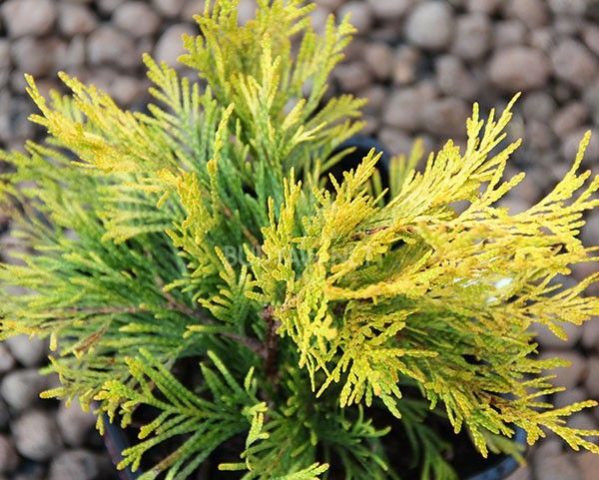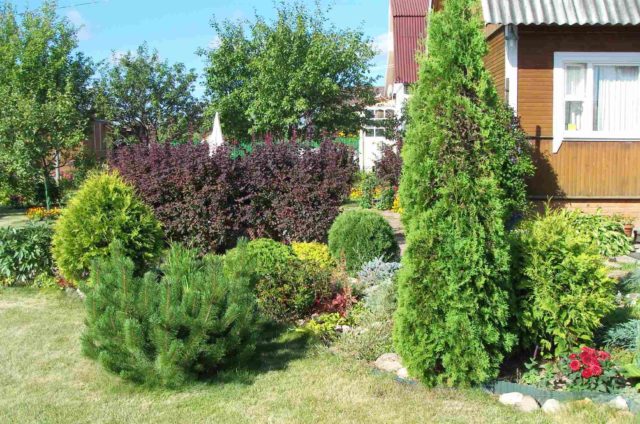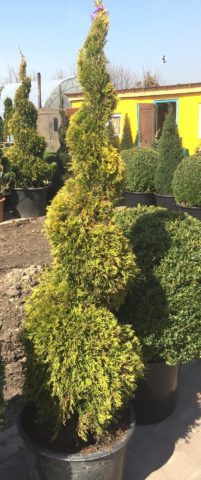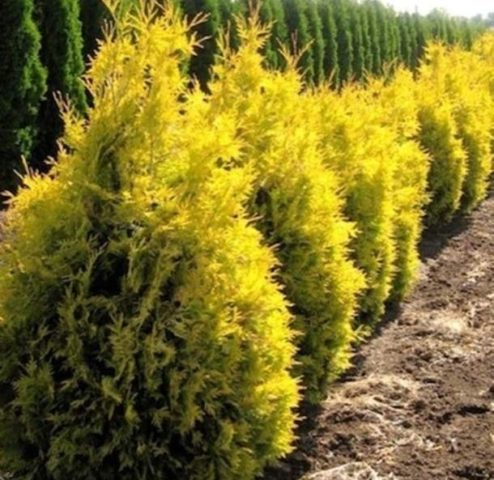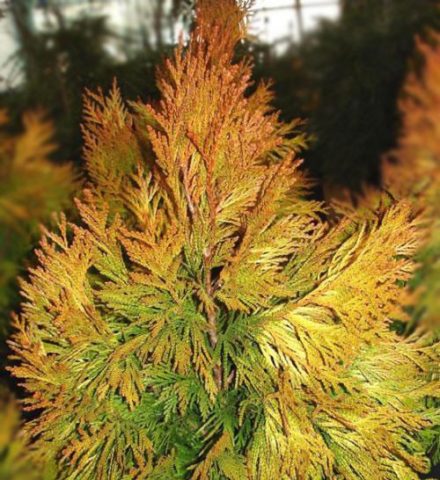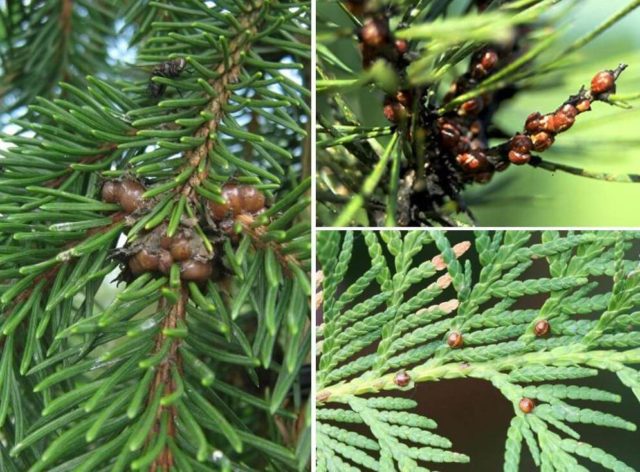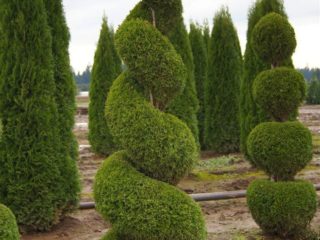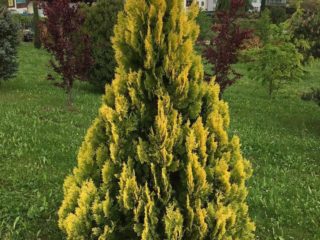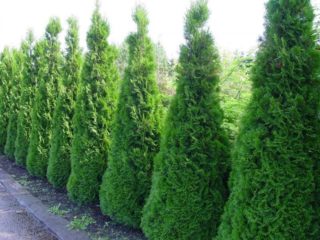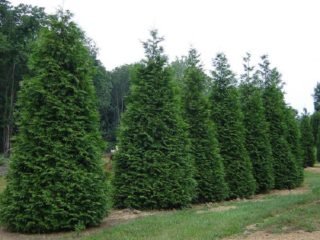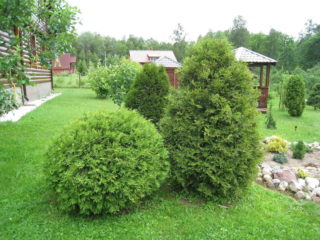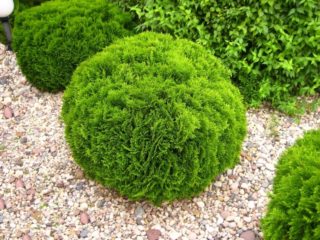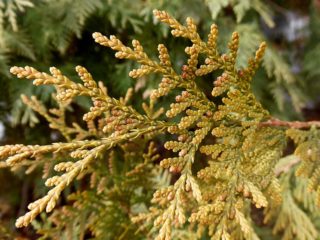Content
Thuja plica Forever Goldie is becoming increasingly popular among gardeners every year. The new variety quickly attracted attention. This is explained by the good characteristics of thuja: unpretentious in terms of care and attractive to the eye.
Description of Thuja Forever Goldie
The Forever Goldie variety was bred in a Dutch nursery in 2002. It belongs to the Cypress family.
Forever Goldie looks compact, has a cone shape and flat branches. Growth is slow - 10-20 cm in height per year, 5 cm in width. By the age of 10, it reaches 2 m in height and 1-1.5 m in width. The shoots are densely located, strongly flattened. The needles are soft, scaly, directed upward. The bark is fissured, fibrous, reddish-brown, 1-2.5 cm thick.
The folded thuja is characterized as an evergreen tree or shrub.
Forever Goldie amazes with its richness of colors. In summer, thuja has light green shades; when the temperature drops to +5°C in autumn, it mixes bright yellow and orange-golden colors.In winter, thuja takes on shades of gold mixed with yellow. This color lasts until spring. In the description of the photo of thuja foldata Forever Goldie, the orange-red color of young growths and the red-brown bark of adult plants are noted.
The use of thuja Forever Goldie in landscape design
Thuja Forever Goldie is widely used in landscape design. Together with oriental spruce, hemlock and other types of coniferous trees of the Cypress family, they make up compositions in the garden plot. Forever Goldie tolerates urban conditions well, so it is often used in the design of parks and squares.
To ensure that the thuja fits harmoniously into the composition, trim it to the desired shape.
Forever Goldie is also used as a hedge. This variety was bred specifically for yellow hedges.
Features of reproduction
Thuja foldata Forever Goldie propagates in two ways:
- cuttings;
- seeds.
The first method of reproduction is widespread. Growing from seeds gives a small percentage of germination. If you choose the seed method, then it will take at least 5-6 years to obtain a new full-fledged thuja shrub.
Landing rules
In order for Forever Goldie to easily adapt to new conditions, you need to plant it correctly. The moment when the thuja is just undergoing adaptation to a new place is considered the most crucial. At this time, thuja is subject to stress and external influences from the environment. The landing will be successful if the following factors are taken into account:
- recommended disembarkation dates;
- place and soil where thuja is planted;
- Forever Goldie planting algorithm.
Recommended timing
The best moment is when active thawing of the soil begins, and it ends with the time of shoot formation. The deadline for normal adaptation of the shrub is the beginning of July. During this period of time, folded thuja adapts both to a new place and to a new climate regime. It does not matter whether Forever Goldie previously grew in a container or is planted directly from the ground.
Site selection and soil preparation
Forever Goldie is an unpretentious variety of thuja. Grows on any soil.
But there are certain preferences: slightly acidic or neutral soil with good drainage and watering. Soil acidity pH 4.5-6.0 will be optimal for Forever Goldie. When choosing soil for thuja, you need to rely on these data. Forever Goldi is considered a shade-tolerant plant. But an area completely deprived of sunlight will have a bad effect on her health. Therefore, areas in a illuminated area with light scattering rays are suitable.
Landing algorithm
When a location has been chosen and the soil has been prepared, you can proceed directly to planting. It includes the following steps:
- Dig a hole for the seedling. Depth 70-80 cm, diameter - 90-100 cm. Dimensions can vary in a different range, the main thing is that the clod of earth with roots fits freely into the hole.
- Soil is placed at the bottom along with organic fertilizer, for example, wood ash.
- The thuja Forever Goldie seedling is placed in a hole so that the root ball and shoots are not damaged. The root collar is placed at ground level.
- Peat, sand, and garden soil are mixed in equal proportions. Next, fill the hole and compact it a little.
More information can be found in the video:
Rules for growing and care
In order for Forever Goldie to develop and grow well, you need to monitor her condition and follow the rules for growing and caring for thuja. Carry out the following procedures:
- watering;
- feeding;
- pruning;
- preparation for winter.
Watering schedule
For Forever Goldie seedlings and adult plants, the watering schedule is of great importance. 10 liters (one full bucket) is the minimum amount of water required by thuja once a week. Water the root area. The most suitable time is twilight or early morning. In hot and dry periods, the number of waterings for thuja increases to 2-3 times a week. At this time, sprinkling is added in the evening.
Top dressing
Forever Goldie needs feeding, like other plants. Thanks to this, the thuja grows faster, acquires the brightness and shine of its needles, and becomes lush. For feeding use:
- Compost. You need to till the soil 1-2 times at the beginning of the season or in the summer.
- Special product for feeding evergreens “Fertika”. It is introduced into loose soil and washed away with water.
Trimming
For the first two years, Thuja Forever Goldie is not pruned. During this time, it must finally take root and adapt to new conditions after planting.
Basic rules for pruning Thuja Forever Goldie:
- beginning of pruning – April;
- throughout the summer and before the onset of cold weather, repeat as needed to maintain shape;
- carry it out only in dry weather;
- Before cutting, remove dry and diseased branches;
- if growth is needed only in width, then the top is cut off completely.
With little pruning experience, it is best to start with simple shapes, for example, “balls” or two-tiered cascades.
Preparing for winter
Thuja Forever Goldie can withstand low temperatures (down to -30°C). Despite this, it needs to be prepared for frost.This is especially important for young plants that need additional insulation. The covering material for thuja is thick greenhouse film or spunbond. Gardening stores offer ready-made covers. To protect the roots, use fallen leaves to cover the surface of the ground. It is enough to protect an adult plant from the accumulation of snow on the branches and roots, and strong winds.
Pests and diseases
Pests.
- Thuja aphid. This is a small gray-brown insect. Affects the lower part of the shoots. At the same time, the thuja begins to turn yellow and fall off.
- Arborvitae moth. It looks like a butterfly, measuring 4 mm. It begins its attack from the upper shoots: they turn brown and then die.
- Gray larch leaf roller. A dark caterpillar that wraps needles in a web. Thuja loses its decorative appearance and may die.
To control pests, insecticides and preparations based on the active substance imidacloprid are used. Apply along the crown and in the root area. In addition, treat the affected areas with a soap solution, avoiding contact with the roots.
Diseases.
- Brown shoots. This is a fungal disease. Individual scales turn yellow, then the entire shoot turns brown and dies. To combat the disease, the affected shoots are cut out and the plant is fed with limestone. From July to October, spray with a 0.2% solution of foundationazole once every 2 weeks.
- Drying of branches. The leaves turn yellow and fall off. To eliminate it, spray it with copper-containing preparations or zineb.
- Phytotophthora. This is a root disease that destroys its top layer. Thuja fades, becomes gray in color, soft to the touch. Late blight occurs in poorly drained areas where water stagnates. Fungicides are used for prevention.When a disease appears, the plant must be destroyed and the soil replaced.
- Schutte and rust. The needles darken and fall off. The affected areas are cut off and burned. To prevent it in the spring, thuja is sprayed with a HOM solution.
- Thuja false scale. The bark is covered with yellow cankers that enlarge and cover the trunk. Thuja dies. You need to treat with Rogor, Karbofos, Actellik, Antio.
Conclusion
Thuja plica Forever Goldie is great for landscape design. This is a new variety that looks great in winter. Forever Goldie is quite easy to care for, and also pleases the eye with its brightness and richness of color all year round.
